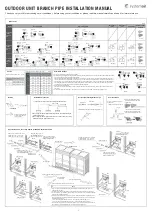
• Connect wires to the appropriate terminals
• For future servicing, leave some slack in the connecting wires.
• Make ground wire a little longer than oth-
ers. (More than 1-9/16 in. [40 mm])
2-1. ATTACHING THE INSTALLATION PLATE
)LQGDVWXGLQWKHZDOOWRDWWDFKLQVWDOODWLRQSODWHKRUL]RQWDOO\E\WLJKWHQLQJWKH¿[LQJ
VFUHZV¿UPO\
• To prevent installation plate (1) from vibrating, be sure to install the attachment screws in
the holes indicated in the illustration. For added support, additional screws may also be
installed in other holes.
• When the indoor unit is to be attached to a concrete wall using recessed bolts, secure
installation plate (1) using 7/16 in. x 13/16 in. · 7/16 in. x 1 in. (11 mm × 20 mm · 11 mm ×
26 mm) oval hole (17-3/4 in. [450 mm] pitch).
,IWKHUHFHVVHGEROWLVWRRORQJFKDQJHLWIRUDVKRUWHURQH¿HOGVXSSOLHG
Wall
Outdoor side
2-2. DRILLING
1) Determine where the holes will be located on the wall.
2) Drill a ø3 in. (75 mm) hole. The outdoor side should be 6/32 to 9/32 in. (5 to 7 mm) lower
than the indoor side.
3) Insert wall hole sleeve (C).
2-3. CONNECTING WIRES FOR INDOOR UNIT
Note:
The unit should be installed by a licensed contractor/electrician. If required by applicable
national, state and local codes; a disconnect switch will need to be installed when the
indoor unit is powered from the outdoor unit.
1) Remove the panel assembly. (Refer to 5-1.)
2) Place the upper part of the indoor unit on the installation plate.
3) Remove corner box and electrical cover.
4) Remove display and i-see sensor assembly, conduit cover and conduit plate.
5) Attach straight joint (for rear piping) / elbow joint (for right, left, or downward piping) to
conduit plate with lock nut. The thread of the installed conduit pipe / elbow joint appearing
inside should be less than 3/8 in. (10 mm). (Fig. 1) Elbow joint should appear less than
1-3/16 in. (30 mm) outside. (Fig. 2)
6) Process the end of ground wire (Fig. 3). Connect it to the ground terminal of electrical parts
box.
7) Process the end of indoor/outdoor unit connecting wire (A) (Fig. 3). Attach it to the terminal
block. Be careful not to make mis-wiring. Attach the wire to the terminal block securely so
that its core cannot be seen, and no external force affects the connecting section of the
terminal block.
8) Firmly tighten the terminal screws. After tightening, verify that the wires are tightly fastened.
9) Reinstall conduit plate, conduit cover and display panel.
10) According to the piping direction, remove the shaded part of the corner box L (Fig. 4) or
corner box R (Fig. 5). Reinstall electrical cover, corner box R and front panel.
Less than 3/8 in.
(10 mm)
Conduit plate
Conduit pipe or
elbow joint
Lock nut
6/32-9/32 in.
(5-7 mm)
ø3 in.
(75 mm)
Lead
wire
19/32 in.
(15 mm)
Indoor terminal
block
Fixing
screw
Conduit cover
Lock nut
Conduit plate
Elbow joint
(for right, left, or downward piping)
Elbow joint
(for right, left, or downward piping)
Less than 1-3/16 in.
(30 mm)
Corner
box R
Remove corner box
R for piping on right
side of unit
Remove corner box R
for piping on bottom
side of unit
Fig. 1
Fig. 2
Fig. 3
Fig. 4
Fig. 5
Coner
box L
Remove coner
box L for piping
on left side of unit
Remove coner box L
for piping on bottom
left side of unit
Level
Installation plate (1)
Center of ø3 in.
(75 mm) hole
5-1/4 in.
(132.5 mm)
or more
4-7/8 in.
(122.5 mm)
or more
3-3/8 in. (85 mm) or more
5-11/16 in. (143 mm) or more for left/
left rear piping (using spacer)
Ceiling
Wall
Attachment
screw (2)
* Same for left hole.
4-3/4 in. (120 mm)
INDOOR UNIT
Terminal block
208/230 V AC
1phase, 60 Hz
Grounding
terminal**
Disconnect
switch*
OUTDOOR UNIT
Grounding terminal**
Ground
Power supply 208/230 V AC,
1phase 2wires.
60 Hz
Terminal block 1
Terminal block
Terminal block 2
Electrical cover
Electrical box
Display and i-see
sensor assembly
Straight joint
(for rear piping)
Conduit plate
or
Wall
2. INDOOR UNIT INSTALLATION
Insert
the
scale. *
Align the
scale with
the line. *
15/18
06/09/12
Remark:
* A disconnect switch
should be required.
Check the local code.
** Use a ring tongue termi-
nal in order to connect a
ground wire to terminal.


























